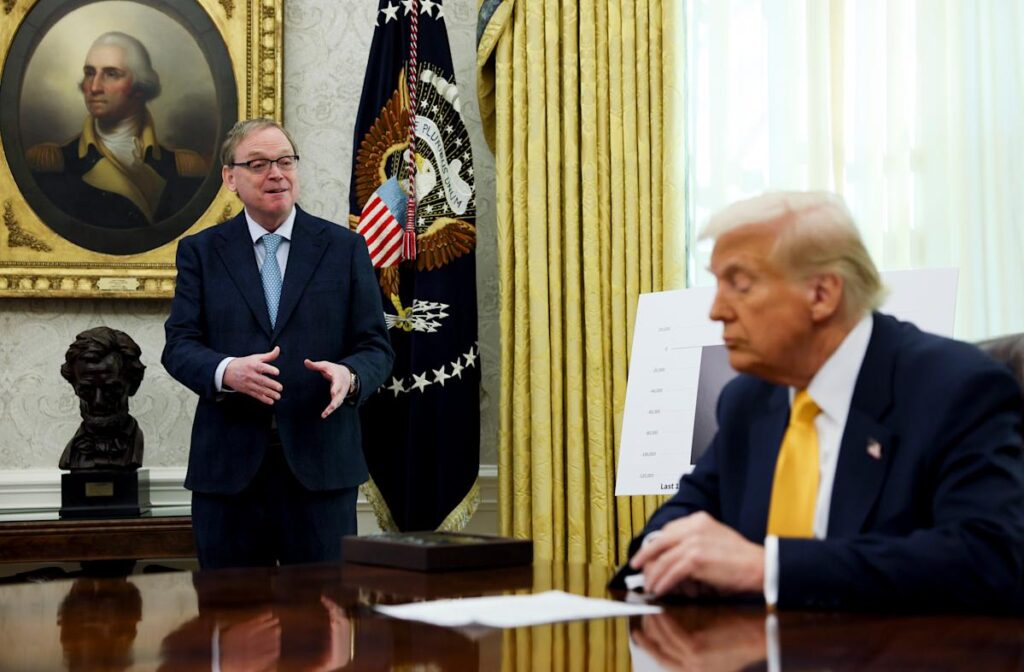President Donald Trump and top Republicans have heralded the “big, beautiful bill” as a catalyst for a massive economic expansion that will unleash corporate investment and household spending.
That won’t be an easy bar to clear.
The economic stimulus that could come from the larger individual tax breaks and new deductions for businesses is likely to be offset by the bill’s hefty cuts to the social safety net and its elimination of previous corporate incentives. While budget analysts and economists say it could moderately contribute to output, they consider the administration’s sunny economic forecasts overly optimistic — particularly given the drag that higher tariffs and deficits could have on growth.
“This is definitely not a growth vehicle,” said Kent Smetters, a University of Pennsylvania business professor who serves as the faculty director of the Penn Wharton Budget Model.
The main elements of Trump’s 2017 tax bill, including lower corporate rates, were already permanent, Smetters said. What’s more, many of the largest deductions included in the new bill are only temporary, including highly touted provisions that allow businesses to deduct capital investments and R&D expenses.
That will make some of the immediate growth effects “a bit of a mirage,” he said.
The White House Council of Economic Advisers estimated that an earlier draft of the bill — specifically the tax provisions that cleared the House Ways and Means Committee last week — would add 4.2 to 5.2 percent to gross domestic product over the next four years compared to what would occur if Congress allowed existing tax cuts to expire. That report was central to the administration and House Republicans’ case that the tax bill would not only preserve the status quo but unlock an economic boom.
Kevin Hassett, the head of Trump’s National Economic Council, told Fox Business earlier this week that he anticipates annual growth will exceed 3 percent over the coming years — a level of economic success that few modern presidents have consistently enjoyed. If that happens, the “tax bill basically pays for itself,” Hassett said.
Joe LaVorgna, the chief economist at SMBC Nikko Securities and a former Trump economic adviser, said he believes that the president’s second-term economy is on a much stronger trajectory than most other economists assume and that the tax bill could push it even higher.
“The baseline I’m working off of is how we did during the first three years of Trump 1.0, when GDP was at 2.8 percent. If it was 2.8 percent [then], why can’t it go to 3.0 percent?” LaVorgna said. “If we grow at 3 percent, then the cost of this bill is going to be extremely limited compared to what everyone out there is saying.”
Other estimates of how the bill’s policies will impact GDP are far more muted. The nonpartisan Joint Committee on Taxation on Thursday said the measure would increase annual growth by just 0.03 percentage points — from 1.83 percent to 1.86 percent. Penn Wharton’s May 19 report on the legislation’s economic effects estimated that GDP would climb by 0.5 percent by 2034 — but that assumes Trump drops tariffs back to pre-April 2 levels, Smetters said.
In a client note, Goldman Sachs economists said they anticipate negative growth when spending cuts, tariffs and changes to immigration were layered on top of the pro-growth policies included in the House GOP’s legislation.
While there are certainly components of the legislation that are stimulative — including boosts to the standard deduction, child tax credit and temporary revival of valuable corporate deductions — they’re not huge. Goldman’s analysis said they could positively affect year-over-year GDP by somewhere between 0.5 and 1 percentage point by mid-2026.
Those effects are moderated by other provisions that could dent household finances and investment. The bill includes hefty cuts to Medicaid and the Supplemental Nutrition Assistance Program that will likely trim health care and consumer spending. Opportunities for clean energy projects that were incentivized by President Joe Biden’s Inflation Reduction Act would be substantially diminished.
White House spokesperson Kush Desai said Republicans had voted to “prevent a $4 trillion tax hike, the largest in American history, on American families when they passed The One, Big, Beautiful Bill.”
“Locking in President Trump’s first-term tax cuts will give American businesses and families the confidence they need to invest in the future,” he said in a statement. “Additional relief for working-class Americans — by eliminating taxes on tips and overtime — and rewarding American manufacturing with full equipment and factory expensing will turbocharge America’s economic resurgence.”
Notably, Wall Street has blanched at the bill’s price tag. Investor appetite for U.S. debt securities weakened over the last week amid a broader reckoning over the growing likelihood that deficits will continue to climb for the foreseeable future, putting upward pressure on long-term interest rates. That trend has likely been exacerbated by notions that protectionist trade policies may weaken the attractiveness of U.S. markets in the future, Smetters said.
“The government is going to have to try to sell these bigger deficits, this bigger amount of debt, in a world where [investors] have less global demand for that debt because of tariffs and trade,” he said.
Read the full article here


